Appreciating Flowers in the Yangtze Delta Region
With the gentle spring breeze brushing your face and the winter chill retreating, it's time to celebrate the best time of the year with a spring outing!
Spring flower appreciation, camping, boating tours and a feast for the stomach, here are some tips to escape the urban treadmill and enjoy springtime in the Yangtze River Delta region.
Hangzhou
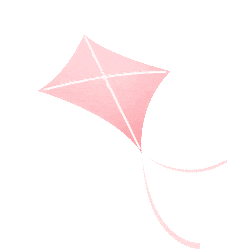
Taiziwan Park
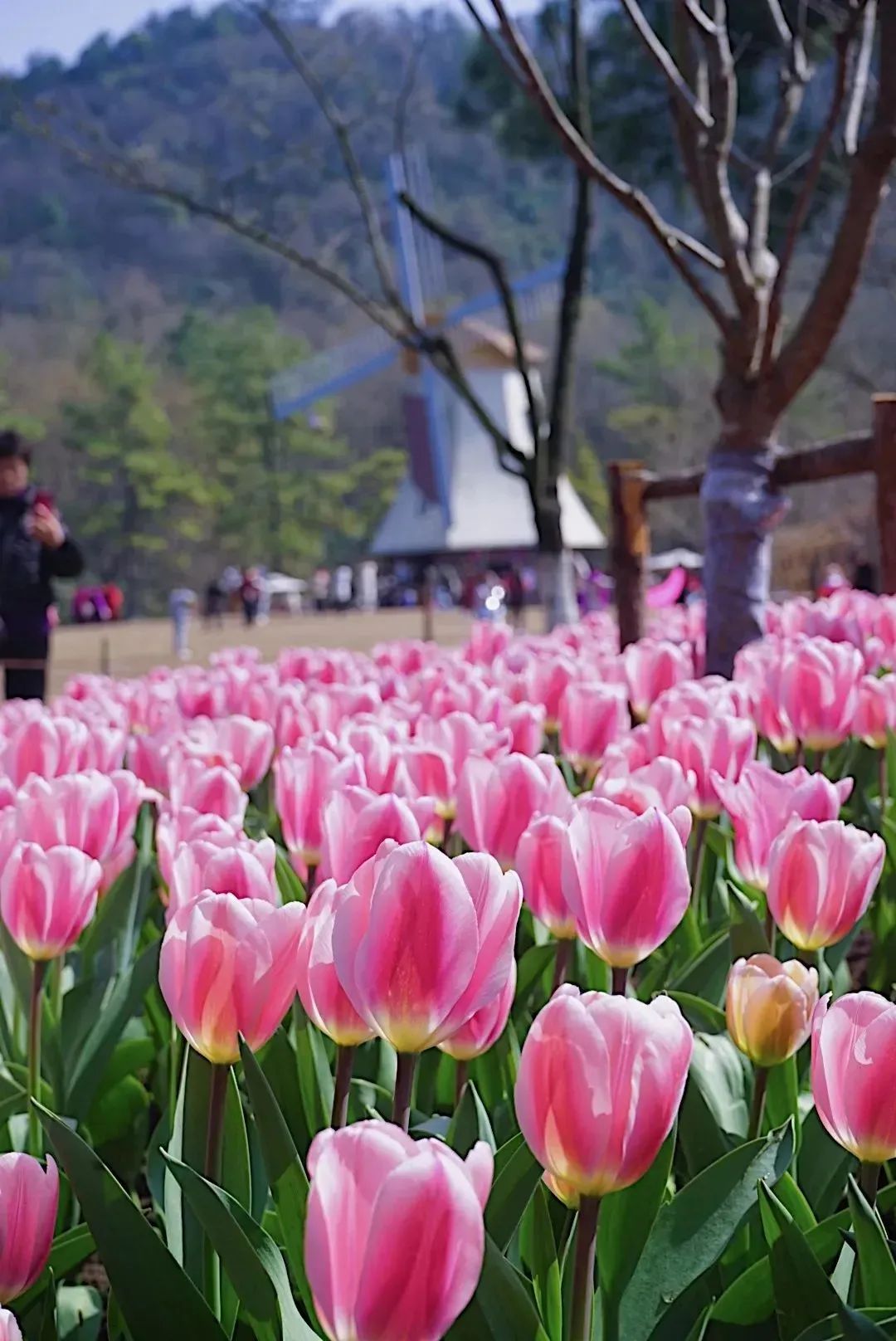
Tulips bloom at Taiziwan Park in Hangzhou, Zhejiang Province
The tulips in Taiziwan deserve a special mention. Every March and April, Hangzhou's Taiziwan Park is a must-visit choice for tulip lovers. The tulips here have a long blooming period and come in a wide variety of species. Over 400,000 tulips bloom at the same time, filling the eyes with stunning colors like a palette of nature.
In Taiziwan, the tulips lean slightly, casting a splash of colorful dyes onto the lake surface.
In March, residents of Hangzhou head to Taiziwan to attend a romantic "spring rendezvous."
Hundreds of thousands of tulips, cherry blossoms and hyacinths bloom in spring. The park is spruced up as an ocean of flowers, as if one were standing in an oil painting, exuding a strong spring atmosphere.
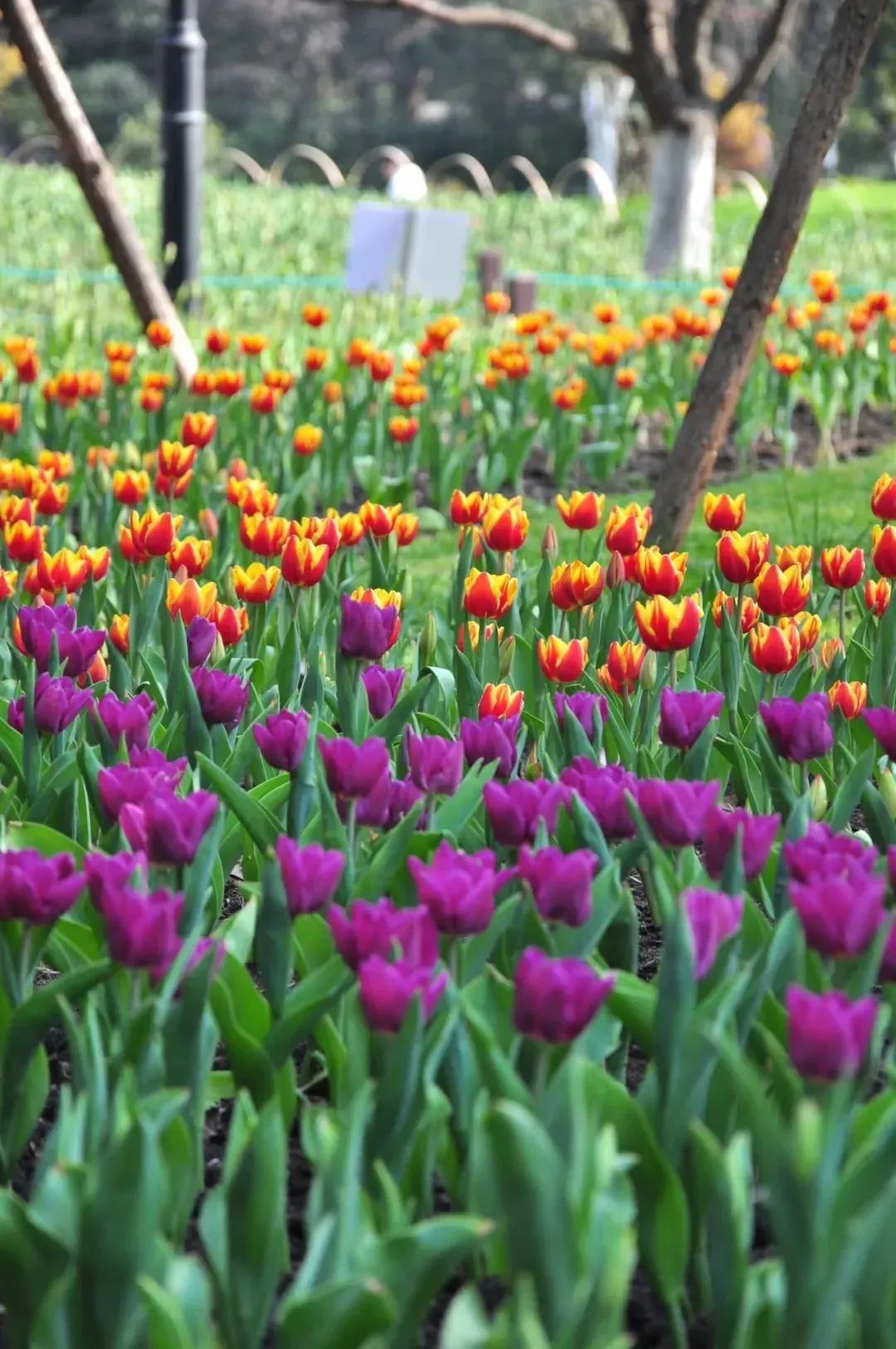
Tulips add a splash of color to Taiziwan Park.
In fact, March and April are the most beautiful months in Hangzhou, the Zhejiang Province capital, for tourists.
By the West Lake, the weeping willows sway gently, and peach blossoms are just beginning to bloom. Strolling along the Su Causeway and the Broken Bridge, every step reveals a new scenic view. Visit the lakeside to admire cherry blossoms, and head to Faxi Temple to experience Zen tranquility.
The Liangzhu Cherry Blossom Avenue is tinged in pink. Take a boat from the "Three Pools Mirroring the Moon" to the Yingzhou Isle, where the lake breeze caresses your face and the setting sun bathes the Leifeng Pagoda in a golden light, instantly giving a golden hue to the entire lake surface.
The Lingyin Temple, Qiandao Lake Scenic Area, Xixi Wetland Park and Songcheng Theme Park are also worth a spring outing in Hangzhou.
Appreciation duration: Now to early April
How to get there: Take high-speed train to Hangzhou Station, then take Metro Line 1 to Longxiang Bridge Station, and take Bus No. 510 and get off at Sudi Stop.
Wuxi

Yuantouzhu (Turtle Head Isle)
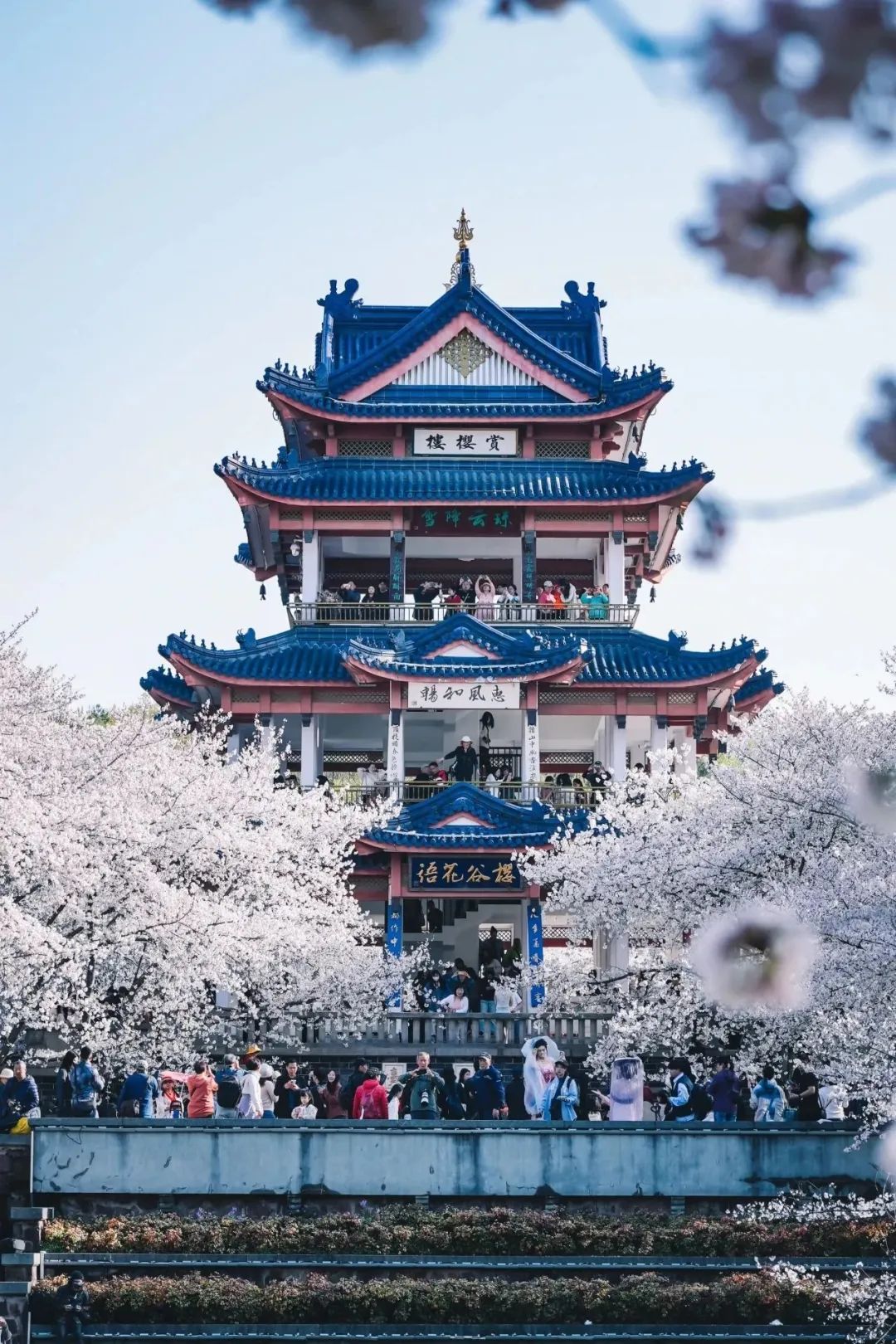
Yuantouzhu in Wuxi, Jiangsu Province, is known as one of the best spots to appreciate cherry blossoms in China.
On the northwest side of Taihu Lake in Wuxi, the spring scenery in Yuantouzhu is incomparable due to a massive pink blanket.
Every spring, more than 30,000 cherry blossom trees bloom exuberantly amidst the lush green mountains and waters.
As one of the "three great cherry blossom viewing spots in the world," the cherry blossoms here are as abundant as clouds and as colorful as rosy rays, complemented by the waterside pavilions, and other elements of typical Jiangnan (region to the south of the lower reaches of the Yangtze River) garden, creating a truly picturesque and poetic scene.
Yuantouzhu has one of the largest cherry orchards in the country and early cherry blossoms are now in full bloom here.
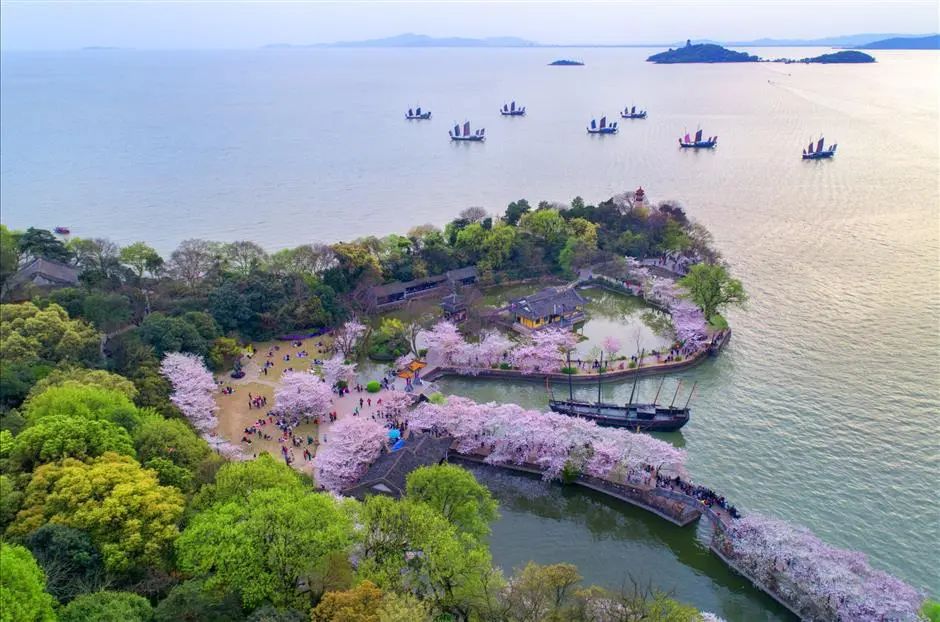
A bird's-eye view of Yuantouzhu.
In addition to cherry blossom, Yuantouzhu has been immortally dubbed "The Nicest Corner by Taihu Lake" by renowned writer Guo Moruo. It promises an ideal panorama of the lake.
Wuxi is actually a hidden gem of Jiangsu Province. The Taihu Lake is the heart and soul of the Jiangnan region and Wuxi is a popular destination for people yearning for a short excursion from Shanghai.
It boasts diversified tourist attractions from the Lingshan Grand Buddha Scenic Area and Liyuan Garden to Yixing Bamboo Sea and the Nianhuawan (or Nianhua Bay) scenic area. As a world-class Zen travel destination, Nianhuawan features Zen-style architecture, Nianhua Tower, a Tang-style wooden pagoda, a Zen-themed street, and Wudeng Lake.
Huishan (Mount Hui), whose elegance and charm was endorsed by Emperor Qianlong as "The Top Mountain in Jiangnan," is famous for its ancestral temples and clay figurines.
Appreciation duration: Now to Early April
How to get there: Take high-speed railway to Wuxi Station, then take Leyou No. 1 Bus to Yuantouzhu Chongshan Gate Stop.
Taizhou

Xinghua Qianduo Canola
Scenic Area
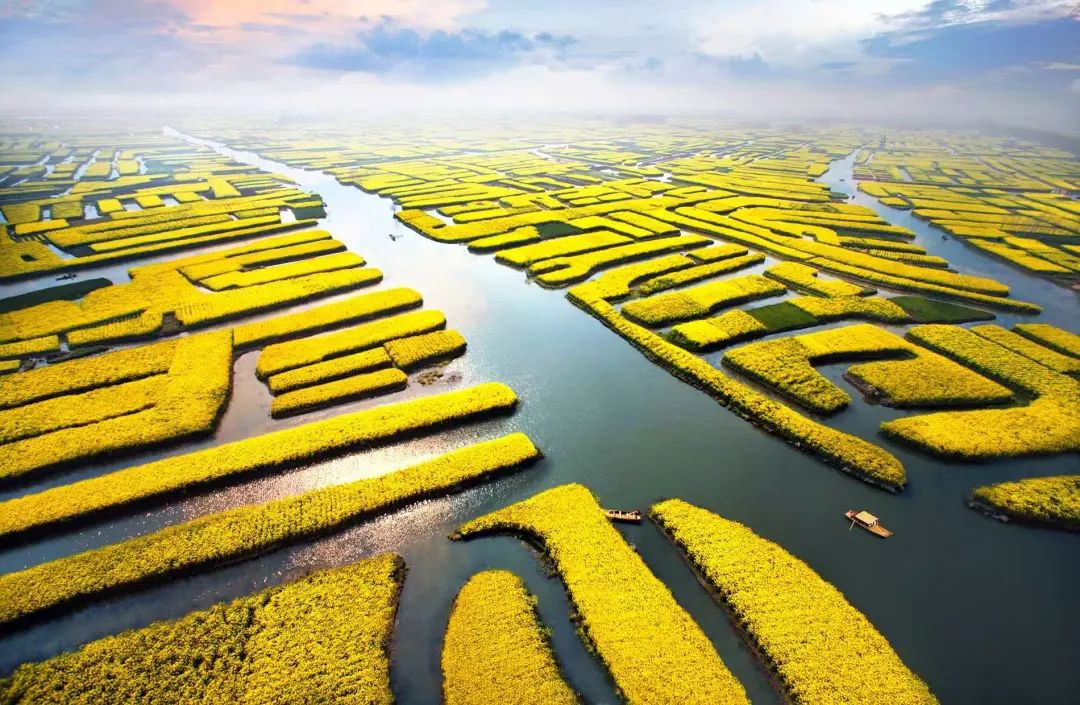
A golden view at the Xinghua Qianduo Canola Scenic Area in Jiangsu Province.
Every spring, the scenic area in Jiangsu Province, covered with blooming flowers, welcomes its most beautiful moment.
Golden canola flowers bloom on the stack-shaped fields, resembling countless golden islands floating in the water. The endless expanse of yellow stretches to the horizon, presenting a picturesque scenery and covering the area in gold.
With vast paddy fields, crisscrossing waterways, and fragrant flowers, each canola basks in the warm sunlight, shimmering with dazzling brilliance. As the breeze blows, the golden sea of flowers surges, as if it were nature's gentlest brushstroke, painting vivid pictures on the vast land.
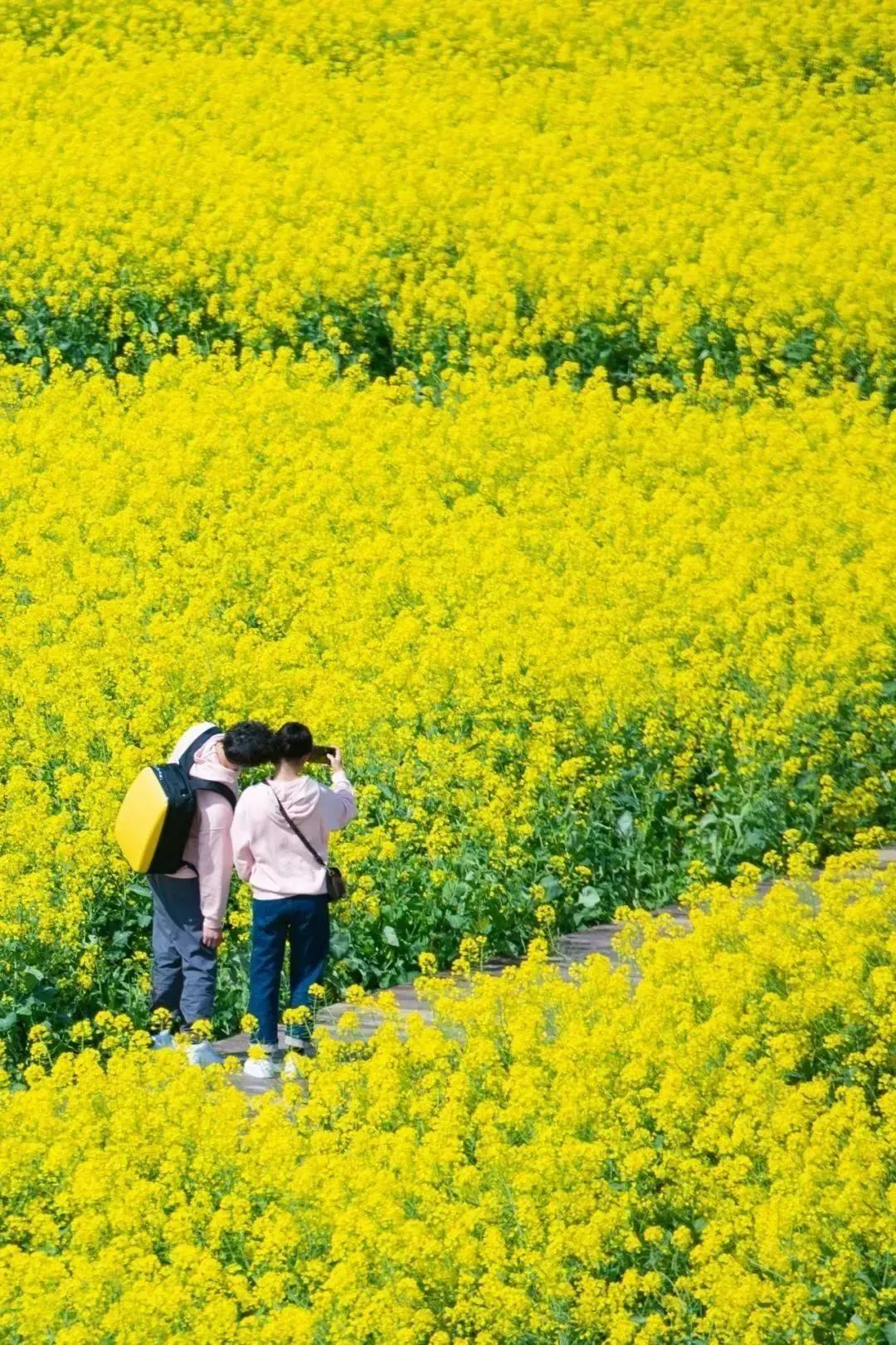
A photo moment at the Xinghua Qianduo Canola Scenic Area
The view attracts countless photography enthusiasts to capture the fleeting moments of beauty and intoxicates every visitor with its tranquility and charm.
Boarding a small boat rowed by a boatwoman and traveling through the flower-blanketed fields feels like wandering in a painting.
The canola flower sea here is renowned as one of the world's four major flower seas, alongside the French lavender, Dutch tulip and Japan's Kyoto cherry blossoms.
If you visit Taizhou, come hungry as the city is a real haven for foodies with its unique morning tea culture. From steamed dumplings stuffed with crab roe to Huangqiao shaobing, a type of flat bread, it tempts travelers with local mouthwatering delicacies. There are also hairy crabs, gansi (dry, sliced bean curd), Xinghua fish balls and Diaopu Wanzhuang mutton.
Taizhou's hairy crab is famous for its green back, white belly, delicate meat and fresh taste. It's morning tea has a long history of hundreds of years, and the tradition of "tea and noodles" has become a "must-have course" for locals in the morning.
Appreciation duration: Now to Early April
How to get there: Take high-speed railway to Taizhou Station, then transfer to Taizhou Xinghua Line and get off at Jiahong Haoting Stop, and then take Xinghua Tour Bus No. 1 or No. 2 to Pingwanghu Stop.
Nanjing

Chaotian Palace
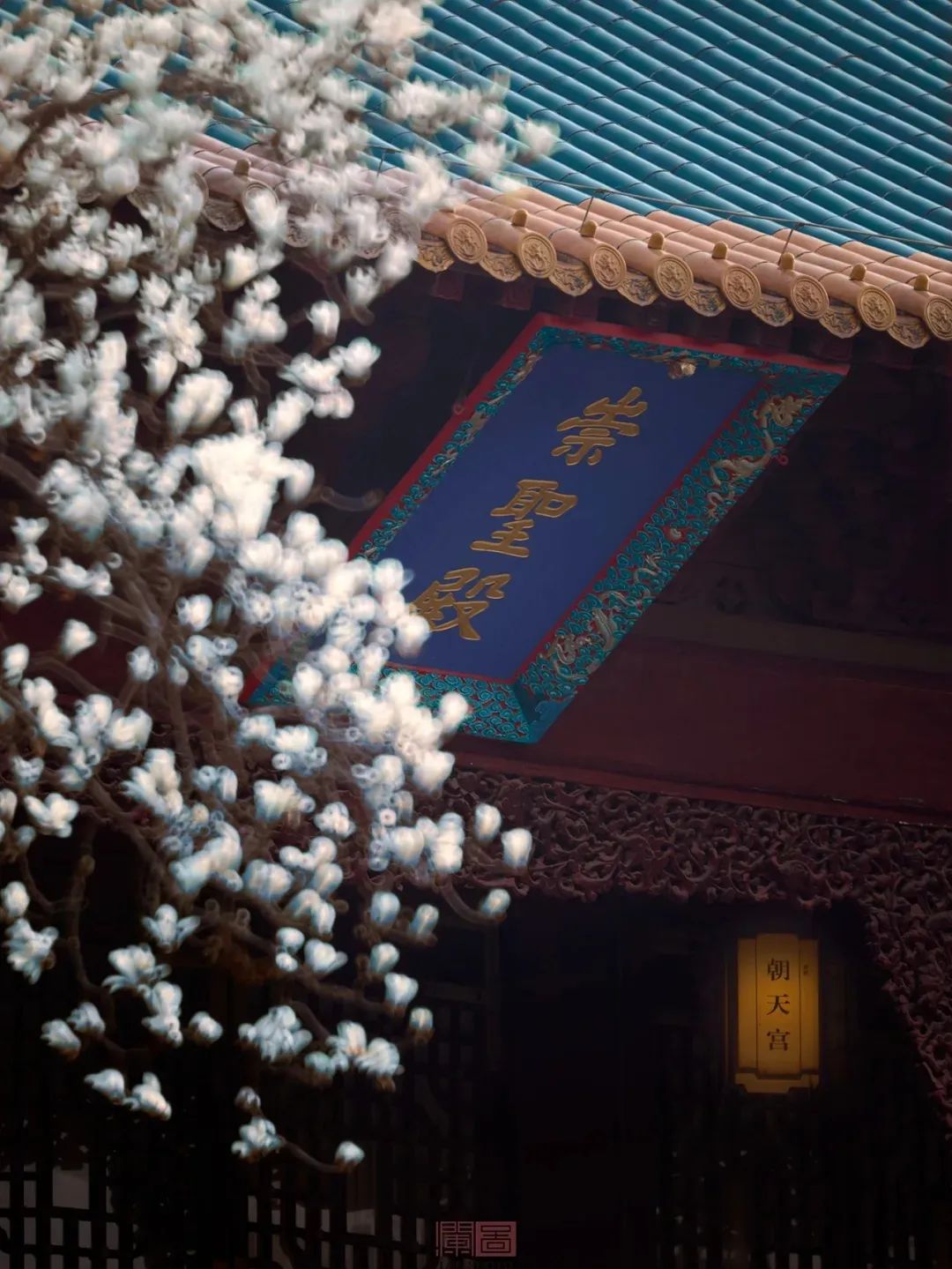
Magnolias in Nanjing's Chaotian Palace
The magnolias in Nanjing's Chaotian Palace are in full bloom, with snow-white flowers adorning the branches, forming a picturesque contrast to the ancient and elegant red walls and green tiles, attracting many people to admire and enjoy the spring atmosphere filled with subtle fragrance.
The white magnolias shine like jade against the red walls and green tiles. Under the sunlight, the dewdrops on the petals glisten, presenting an enchanting sight.
The best place to view magnolias in Chaotian Palace is at the Chongsheng Hall. The magnolias on both sides of the hall sway gently in the wind, emitting a subtle fragrance.
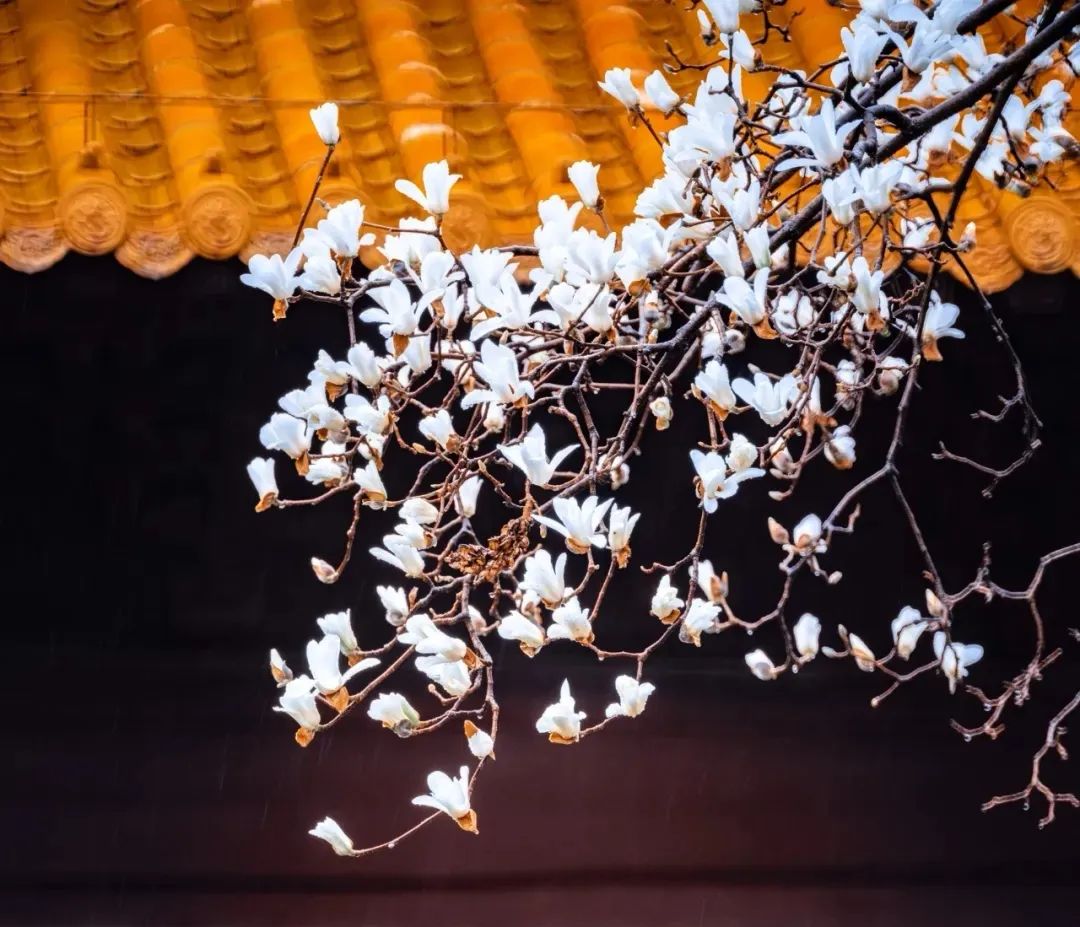
Magnolias cast a contrast to Chaotian Palace.
The magnolia symbolizes "purity and nobility," representing sincere friendship and love.
Chaotian Palace, located in the Qinhuai District of Nanjing, is the highest-ranked, largest, and best-preserved group of Ming Dynasty (1368-1644) and Qing Dynasty (1644-1912) official-style ancient buildings in the Jiangnan region. It has been crowned as the "No. 1 Scenic Spot in Jinling (Nanjing)."
A spring tour in the Qinhuai Scenic Area is a true delight. The inner Qinhuai River is the cream of the Qinhuai scenic area as it is awash with many scenic and cultural spots such as the famous Confucius Temple, Dongshuiguan Park with historical remains, Egret Park, the Jiangnan Imperial Examination Center, Jade Garden Park, and the former residence of businessman Shen Wanshan.
A night boating tour on the river is highly recommended as the scenery is more charming with lanterns lit up.
Appreciation duration: Now
How to get there: Take high-speed railway to Nanjing South Station, and take Metro Line 1 and get off at Zhangfuyuan Station
Suzhou

Shushan Village

White pear flowers are in full bloom in Shushan Village, Suzhou.
Not as popular a flower as the colorful tulip or the pink cherry, pear blossoms seem to be a relatively niche flower. But wait, when thousands of pear blossoms burst into full bloom, it presents breathtaking beauty just like a dreamlike snowy white world.
Shushan in Suzhou's Huqiu District is about to welcome a grand pear blossom festival. Over 4,000 mu (2.67 square km) of pear trees will bloom simultaneously, as if overnight, creating a breathtaking scene and taking you into a romantic sea of flowers.
Looking out from an elevated place, you can see the entire village covered in "snowy white," a truly captivating sight.
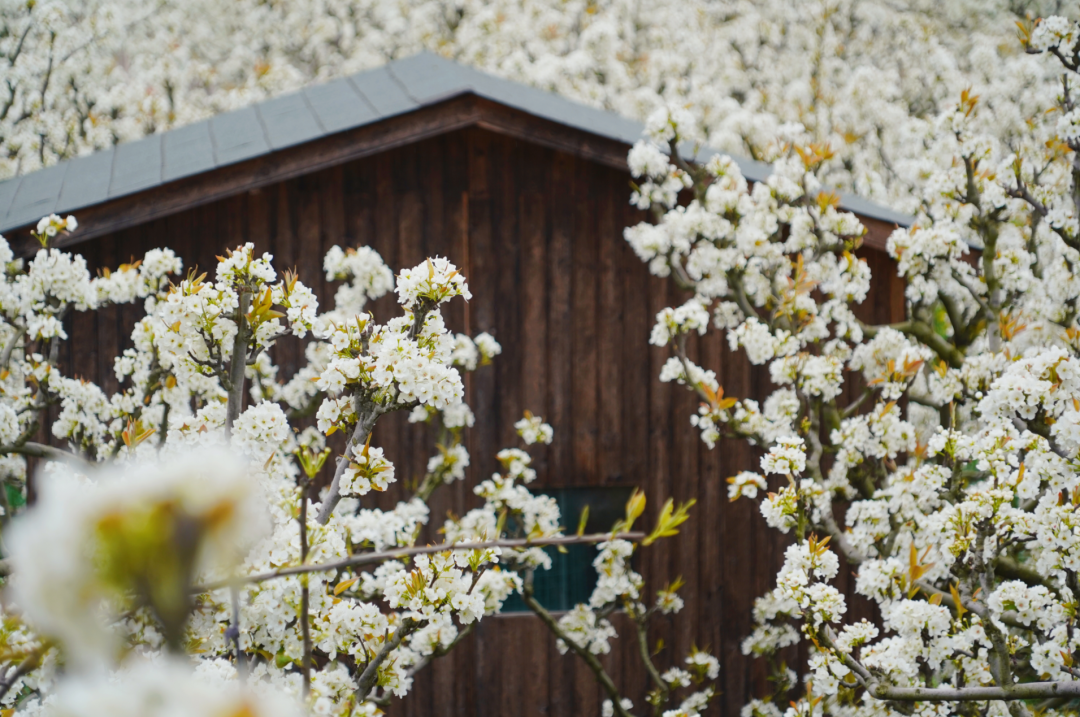
White pear flowers are in full bloom in Shushan.
Nestling between Dayang and Jilong mountains, Shushan is a hidden paradise. The village's hills are covered with pear, waxberry, bamboo shoot and tea plants, as well as fruit and vegetable trees. It is crisscrossed with paths.
Shushan itself is worth a visit.
The local farmhouses offer a wide variety of authentic meals. In spring, you can also enjoy freshly made green rice balls (qingtuan), with a soft and chewy texture that leaves a lasting flavor.
Shushan features a five-kilometer wooden boardwalk, perfect for a weekend short hike. You can enjoy the fresh air without feeling too exhausted. Additionally, climbing the mountain to view the cliff inscriptions is also a great option.
As the backyard garden for people from Shanghai, Suzhou is famous for its Zhuozheng Garden, also known as the Humble Administrator's Garden, Tiger Hill, Lion Grove, Liuyuan Garden and Canglang Pavilion.
Appreciation duration: Now to early April
How to get there: Take high-speed railway to Suzhou Station, and take Bus No. 85 and get off at Wuxian Middle School, and transfer to Shushan Tourist Line and get off at Shushan Village.
Deqing

Moganshan

An enchanting view of begonias in Moganshan, Zhejiang Province
In ancient times, people often used begonias to metaphorize the exquisite makeup of young girls, just like the sea of blooming begonias in March.
"Layer upon layer of new green among the branches, with a few dots of red hidden in the small buds." When begonias bloom, they display an elegant and graceful demeanor, with their bright red flowers resembling rosy clouds.
Since ancient times, begonias have been a beloved for literati and poets, earning such beautiful titles as "the Empress of Flowers" and "national beauty."
In the "Flower Catalogue" by Jia Dan of the Tang Dynasty (AD 618-907), it is called "the flower of immortals." Poet Lu You's "Though beautiful without vulgarity, truly noble and wealthy" captures the elegant beauty of the begonia in bloom.
Moganshan in Zhejiang Province is one of the top summer resorts in China. However, did you know that it is also one of the best spots to appreciate begonias?
On both sides of the Sanmo Line (Sanqiao-Moganshan Highway) in Moganshan Town, the begonias will soon be in full bloom.

A panoramic view of Moganshan
Under the sunlight, clusters of delicate and vibrant begonias bloom in the fields, like pinkish rosy clouds adorning the verdant wheat fields. The petals, as soft as silk, sway gently in the breeze, emitting a faint fragrance that draws bees and butterflies to flutter around.
Moganshan offers a good weekend respite from Shanghai, ideal for hiking and other exercises close to nature.
The numerous historical celebrities associated with Moganshan have not only brought it immense fame but also left behind countless poems, inscriptions, anecdotes, and over 200 villas of various styles and elegant shapes.
Deqing, within two hours' drive of Shanghai, features picturesque landscapes of mountains, lakes and wetlands. It also boasts Xiazhu Lake and Xinshi Ancient Town with a history dating back more than 1,700 years.
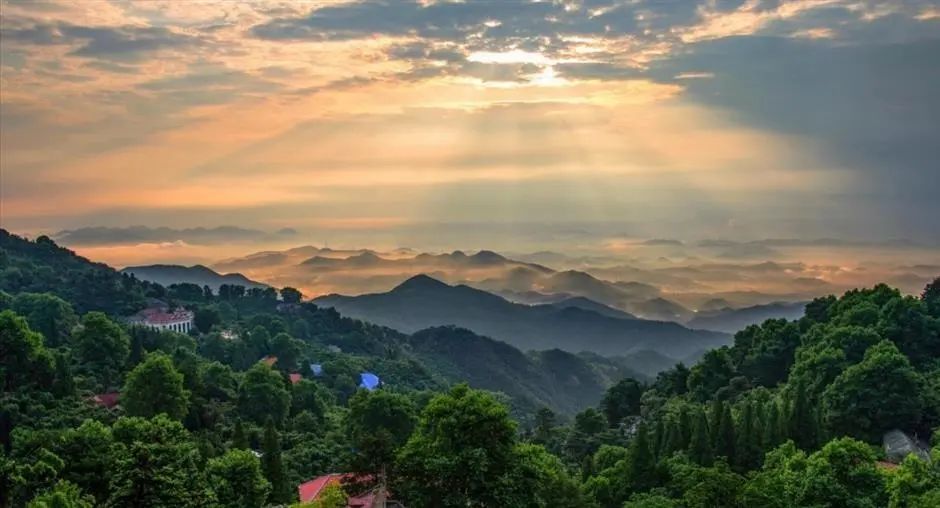
Another panoramic view of Moganshan
Appreciation duration: Now to early April
How to get there: Take high-speed railway to Deqing Station, and take Bus Deqing Y1 and get off at Moganshan Town Stop.




If you plan to travel further, Luoyang in central Henan Province, Nyingchi, southwest China's Xizang Autonomous Region, and Luoping in southwest China's Yunnan Province; are famous spots to appreciate peony, peach blossom and canola flowers, respectively.
Luoyang, as the ancient capital of 13 dynasties, has a history of over 5,000 years. As one of the important cradles of Chinese civilization, it has a cluster of 102 museums interconnected with six World Cultural Heritage sites.
Nyingchi is famous for its dreamy pink visual feast of peaches, whereas Bayi's Gala Village is known in Xizang as the "First Village of Peach Blossoms."
via:City News Service



